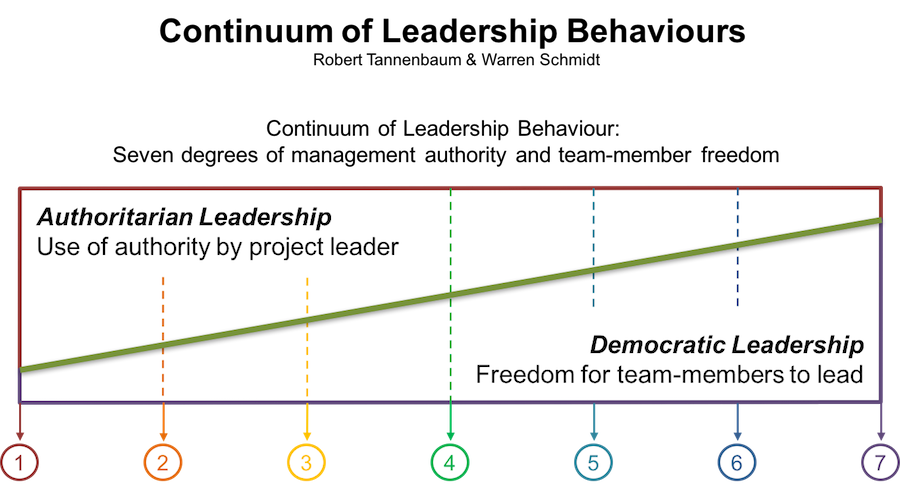Among many types of model of leadership is one that is particularly useful to practical day-to-day managers: situational leadership. And by far the best version of this idea was developed by two UCLA professors, Robert Tannenbaum and Warren Schmidt. Their 1958 article (reprinted in 1973) is one of the most reprinted from Harvard Business Review.

Robert Tannenbaum
Robert Tannenbaum was born in 1916, in Colorado. He studied at The University of Chicago, gaining an AB in Business Administration in 1937, and his MBA in 1938. The following year, he started his PhD in Industrial Relations also at Chicago, but his studies were interrupted by the war.
After serving as a Lieutenant in the US Navy, he returned to his PhD, which he defended in 1948. From there, he went to teach at the UCLA’s Anderson School of Management, where he remained until his retirement in 1977.
Warren H Schmidt
Warren Schmidt was born in 1920, in Detroit, and took a Bachelor’s degree in Journalism at Wayne State University. He then became ordained as a Lutheran minister.
He changed direction again, and after gaining his PhD in Psychology at Washington University, he went to teach at the University of Southern California and UCLA’s Anderson School of Management, where he met Tannenbaum.
By the by, Schmidt is the first of our Management Thinkers and Doers who has won an Oscar. In 1969, he wrote an Op Ed piece for the LA times, titled ‘Is it Always Right to be Right’. This was well received and turned into a short animated movie, narrated by Orson Welles. It won the Academy Award for Best Short Animated Film in 1970.
The Leadership Behaviours Continuum
In what is regarded as a classic 1958 Harvard Business Review article, ‘How to Choose a Leadership Pattern‘, Robert Tannenbaum and Warren H Schmidt set out a range of leadership behaviours. They set out seven distinct stages on a continuum, which vary from telling team members their decision, through selling their idea and consulting on the problem, to handing over decision-making.

A range of behaviours from the purely authoritarian ‘Manager makes a decision and announces it’ through five intermediate styles, to the most democratic ‘Manager allows group to make a decision’ within appropriate constraints.
Equally valuable is their assessment of how a manager can decide how to lead and choose which of the styles will work best. They argue you must consider three forces:
- Forces in the manager
Your values and style, and your assessment of the risk - Forces in the team-members
Your assessment of their readiness and enthusiasm to assume responsibility - Forces in the situation
Time pressure, the group’s effectiveness, organisational culture
This article is a foundation for what is now known as ‘Situational Leadership’, and the two trademarked models developed by Paul Hersey and Kenneth Blanchard.
The Seven Leadership Behaviours
1. Manager makes the decision and announces it
This is a purely authoritarian style of leadership, with no consideration given to other points of view. Most appropriate in a crisis, the manager sets clear instructions and expectations.
2. Manager ‘sells’ their decision
The manager takes the role of decision-maker but advocates their decision, appealing to benefits to the group. Valuable when you need the group’s support.
3. Manager presents their decision and invites questions
The manager is still in control, but allows the group to explore the ideas to better understand the decision. The manager answers to their team, without committing to honour their opinions.
4. Manager presents a tentative decision, subject to change
Now the group’s opinions can count. The manager identifies and resolves the problem, but consults their team before making their own decision.
5. Manager presents the problem, gets suggestions and then makes a decision
Still the manager retains ultimate decision-making authority. But now, they share responsibility for finding the solution with the group, who can influence the final decision.
6. Manager defines the limits within which the group makes the decision
Now decision-making sits with the team. The manager defines the problem and sets boundaries within which the group can operate, which may constrain the final decision.
7. Manager allows group to make decision, subject to organisational constraints
The group has as much freedom as the manager is able to grant them. The manager may help the group and again, commits to respect the decision the group arrives at.
For More Information
This model is fully described, with analysis, in The Management Models Pocketbook.
GAC RIP 2/5/2010
